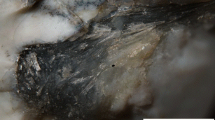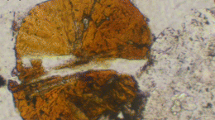Abstract
A new mineral engelhauptite, KCu3(V2O7)(OH)2Cl, was found within cavities in nepheline basalts at the Auf’m Kopp quarry (“Schlackenkegel der Höhe 636 südöstlich Neroth”), Daun, Eifel region, Rheinland-Pfalz, Germany. Associated minerals are volborthite, allophane, malachite, tangeite and chrysocolla; earlier minerals belonging to the primary, high-temperature parageneses are augite, mica of the phlogopite–oxyphlogopite series, sanidine, nepheline, leucite, fluorapatite and magnetite. Engelhauptite occurs as spherulites (up to 0.2 mm in diameter) and bunches consisting of rough spindle-shaped crystals elongated parallel to [0001]. The crystals are up to 0.12 mm long and up to 0.04 mm thick. Individual grains of engelhauptite are transparent, whereas their aggregates are translucent. The mineral is yellow-brown to brown, typically with an olive green hue. The luster is vitreous. Engelhauptite is brittle, cleavage is not observed, fracture is uneven. D calc = 3.86 g cm−3. Engelhauptite is optically uniaxial (+), ω = 1.978(4), ε = 2.021(4). Chemical data (wt.%, electron-microprobe, H2O by difference) are as following: K2O 9.63, FeO 0.05, NiO 0.29, CuO 46.11, Al2O3 0.24, V2O5 34.92, SO3 0.79, Cl 5.94, H2Ocalc 3.37, O = Cl2 -1.34, total 100.00. The empirical formula, based on 10 (O + OH + Cl) apfu, is K1.05(Cu2.97Al0.02Ni0.02)Σ3.01(V1.97S0.05)Σ2.02O7.23(OH)1.91Cl0.86. Engelhauptite is hexagonal, P63/mmc, a = 5.922(2), c = 14.513(5) Å, V = 440.78(3) Å3 and Z = 2. The eight strongest reflections of the powder X-ray diffraction pattern [d,Å(I) (hkl)] are: 7.32(98) (002), 4.224(17) (102), 2.979(100) (104, 110), 2.759(19) (112), 2.565(18) (200), 2.424(18) (202), 1.765(16) (206) and 1.481(14) (208, 220). The crystal structure of engelhauptite has been solved from the single-crystal X-ray diffraction data and refined to R = 0.090 on the basis of 135 unique observed reflections. The structure is based upon the [Cu2+ 3(V2O7)(OH)2]0 framework formed by the linkage of deficient brucite-like layers of Jahn-Teller distorted Cuφ6 octahedra (φ = O, OH) via divanadate V2O7 groups. The framework contains large channels occupied by K+ cations and Cl− anions. Engelhauptite is closely related to volborthite, Cu3(V2O7) (OH)2∙2H2O, and can be considered as its analogue resulting from the replacement of H2O molecules by the equal amounts of K+ and Cl− ions. The mineral is named in honour of the German amateur mineralogist and mineral collector Bernd Engelhaupt (born 1946).




Similar content being viewed by others
References
Anthony JW, Bideaux RA, Bladh KW, Nichols MC (2000) Handbook of mineralogy. Vol. IV. Arsenates, Phosphates, Vanadates. Mineral Data Publishing, Tucson
Basso R, Palenzona A, Zefiro L (1988) Crystal structure refinement of volborthite from Scrava Mine (Eastern Liguria, Italy). N Jb Miner Mh 385–394
Blass G, Schüller W (2011) “Unglaubliche” Kupfermineralien aus der Vulkaneifel: Auf‘m Kopp bei Neroth. Lapis 36:21–28, 90
Burns PC, Hawthorne FC (1996) Static and dynamic Jahn-Teller effects in Cu2+ oxysalt minerals. Can Mineral 34:1089–1105
Kampf AR, Steele IM (2008) Martyite, a new mineral species related to volborthite: description and crystal structure. Can Mineral 46:687–692
Kashaev AA, Rozhdenstvenskaya IV, Bannova II, Sapozhnikov AN, Glebova OD (2008) Balance, uniformity and asymmetry of the structure of volborthite Cu3(OH)2(V2O7).2(H2O). J Struct Chem 49:708–711
Lafontaine MA, Le Bail A, Ferey G (1990) Copper-containing minerals - I. Cu3V2O7(OH)2 · 2(H2O): the synthetic homolog of volborthite; crystal structure determination from X-ray and neutron data; structural correlations. J Solid State Chem 85:220–227
Leu K (1995) Der vulkanabbau “Auf’m Kopp” bei Oberstadtfeld in der Westeifel. Lapis 2:17–20
Libowitzky E (1999) Correlation of O–H stretching frequencies and O–H · · · O hydrogen bond lengths in minerals. Monatsh Chem 130:1047–1059
Matsubara S, Saito Y, Kato A (1990) Vanadium minerals in siliceous sedimentary rocks from Unuma, Gifu Prefecture, Japan, with special reference to volborthite and roscoelite. J Mineral Petrol Econ Geol 85:522–530
Pekov IV, Zelenski ME, Yapaskurt VO, Polekhovsky YS, Murashko MN (2013a) Starovaite, KCu5O(VO4)3, a new mineral from fumarole sublimates of the Tolbachik volcano, Kamchatka, Russia. Eur J Mineral 25:91–96
Pekov IV, Zubkova NV, Zelenski ME, Yapaskurt VO, Polekhovsky YS, Fadeeva OA, Pushcharovsky DY (2013b) Yaroshevskite, Cu9O2(VO4)4Cl2, a new mineral from the Tolbachik volcano, Kamchatka, Russia. Mineral Mag 77:107–116
Pekov IV, Zubkova NV, Yapaskurt VO, Kartashov PM, Polekhovsky YS, Murashko MN, Pushcharovsky DY (2014) Koksharovite, CaMg2Fe3+ 4(VO4)6, and grigorievite, Cu3Fe3+ 2Al2(VO4)6, two new howardevansite-group minerals from volcanic exhalations. Eur J Mineral 26:667–677
Sheldriсk GM (2008) A short history of SHELX. Acta Crystallogr A64:112–122
Sokolova EV, Hawthorne FC, Karpenko VY, Agakhanov AA, Pautov LA (2004) Turanite, Cu2+ 5(V5+O4)2(OH)4, from the Tyuya-Muyun radium-uranium deposit, Osh District, Kyrgyzstan: a new structure for an old mineral. Can Mineral 42:731–739
WinXPow Software (2002) STOE and CIE GmbH
Zelenski ME, Zubkova NV, Pekov IV, Boldyreva MM, Pushcharovsky DY, Nekrasov AN (2011) Pseudolyonsite, Cu3(VO4)2, a new mineral species from the Tolbachik volcano, Kamchatka Peninsula, Russia. Eur J Mineral 23:475–481
Acknowledgments
We thank two anonymous referees and Associate Editor Anton Beran for the valuable comments. This study was supported by the Russian Science Foundation, grants nos. 14-17-00048 (mineralogical, electron probe and spectroscopic studies) and 14-17-00071 (X-ray diffraction and structural studies). The technical support by the SPbSU X-Ray Diffraction Resource Center is acknowledged.
Author information
Authors and Affiliations
Corresponding author
Additional information
Editorial handling: A. Beran
Rights and permissions
About this article
Cite this article
Pekov, I.V., Siidra, O.I., Chukanov, N.V. et al. Engelhauptite, KCu3(V2O7)(OH)2Cl, a new mineral species from Eifel, Germany. Miner Petrol 109, 705–711 (2015). https://doi.org/10.1007/s00710-015-0400-8
Received:
Accepted:
Published:
Issue Date:
DOI: https://doi.org/10.1007/s00710-015-0400-8




